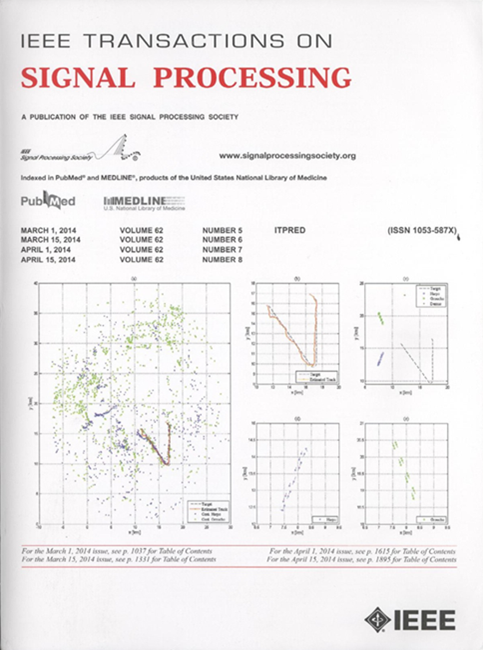次奈奎斯特 USF 频谱估计:K 频率与 6K + 4 模数采样
IF 5.8
2区 工程技术
Q1 ENGINEERING, ELECTRICAL & ELECTRONIC
引用次数: 0
摘要
当奈奎斯特采样率不切实际时,对高带宽信号的数字采集尤其具有挑战性。因此,人们开始广泛研究亚奈奎斯特采样方法,主要用于频谱和正弦频率估计。然而,这些方法在处理高动态范围(HDR)信号时很吃力,因为高动态范围信号会使模数转换器(ADC)饱和。为了解决这个问题,我们利用多通道系统,在无限传感框架(USF)的驱动下,引入了一种新颖的亚奈奎斯特频谱估算方法。亚奈奎斯特 USF 方法在振幅域和频域中都对采样进行了别名处理,这使得反向问题特别具有挑战性。为了实现这一目标,我们的精确恢复定理证明,任意振幅和频率的 $K$ 正弦可以从 $6K+4$ modulo 样本中恢复,而且与采样率或折叠阈值无关。本着亚奈奎斯特采样的真正精神,通过模数 ADC 硬件实验,我们展示了使用 Hz 范围采样率(0.078% 奈奎斯特采样率)在 kHz 范围内成功估计 HDR 信号的频谱。我们的实验还显示,与传统 ADC 相比,使用较少的一位,频率估计精度提高了 33 倍。这些发现为雷达、到达方向(DoA)估计和认知无线电等频谱估计应用开辟了新途径,展示了 USF 的潜力。本文章由计算机程序翻译,如有差异,请以英文原文为准。
Sub-Nyquist USF Spectral Estimation: $K$ Frequencies With $6K+4$ Modulo Samples
Digital acquisition of high bandwidth signxals is particularly challenging when Nyquist rate sampling is impractical. This has led to extensive research in sub-Nyquist sampling methods, primarily for spectral and sinusoidal frequency estimation. However, these methods struggle with high-dynamic-range (HDR) signals that can saturate analog-to-digital converters (ADCs). Addressing this, we introduce a novel sub-Nyquist spectral estimation method, driven by the Unlimited Sensing Framework (USF), utilizing a multi-channel system. The sub-Nyquist USF method aliases samples in both amplitude and frequency domains, rendering the inverse problem particularly challenging. Towards this goal, our exact recovery theorem establishes that
$K$ $6K+4$
求助全文
通过发布文献求助,成功后即可免费获取论文全文。
去求助
来源期刊

IEEE Transactions on Signal Processing
工程技术-工程:电子与电气
CiteScore
11.20
自引率
9.30%
发文量
310
审稿时长
3.0 months
期刊介绍:
The IEEE Transactions on Signal Processing covers novel theory, algorithms, performance analyses and applications of techniques for the processing, understanding, learning, retrieval, mining, and extraction of information from signals. The term “signal” includes, among others, audio, video, speech, image, communication, geophysical, sonar, radar, medical and musical signals. Examples of topics of interest include, but are not limited to, information processing and the theory and application of filtering, coding, transmitting, estimating, detecting, analyzing, recognizing, synthesizing, recording, and reproducing signals.
 求助内容:
求助内容: 应助结果提醒方式:
应助结果提醒方式:


